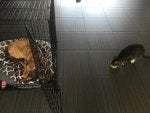We have a 3.5 month old female puppy, living with us (and an 8-yo male cat) for the past 5-6 weeks now. We have tried many things on our own: very careful slow introduction of puppy to cat (did all the smell, food exercises, also did sound desensitizing), baby gates, escape routines and high cat trees, walking puppy twice/day to burn energy, at least 1 hr of training daily with treats, teaching "leave it", "stay". Puppy is doing well overall, except she keeps wanting to chase the cat. "leave it" and "stay" works with food but not cat.
We were advised by our vet and a trainer to have closely supervised interaction, where the cat would hopefully "correct" the puppy by clawing her. Our cat has managed to do that many times (I don't think the cat really used his claw very harshly), but didn't seem to have made any difference to how puppy would want to chase. These interactions sometimes end up in loud barking (when cat hisses and swats).
We just had 2 sessions with a trainer today, who was concerned about our cat's safety after seeing puppy's behaviours. She initially thought it would work out over time, but felt that there was a lot of prey drive in the puppy that something needs to be done before she grows bigger.
The plan was:
1. Briefly use shock collar so puppy learns to avoid.
2. Pair loud noise (banging two pot lids) for future reminder.
3. Reinforce ignoring cat.
So step 1 and 2 have occurred over 2 sessions (1 in the morning the other afternoon). By the end of it (5 - 6 shocks and 2 loud bangs in total; puppy completely ignored the first 3 shocks), puppy was able to stay in her bed and not chase when the cat runs across the floor. Puppy seemed in good mood at the end of the session and got praises and treats for leaving the cat alone.
Now that I have been reading more about e-collar after these sessions, there seems to be a lot of conflicting information. Some sources say that it can be very effective in addressing high prey drive; some also say that there could be unexpected consequences.
Now that this has already been done, my questions is:
1. Would such "brief" e-collar correction paired with other reminders and reinforcement have lasting effects? I read that e-collar training may take repetition.
2. What else can we do going forward after what's been attempted?
Thank you!
We were advised by our vet and a trainer to have closely supervised interaction, where the cat would hopefully "correct" the puppy by clawing her. Our cat has managed to do that many times (I don't think the cat really used his claw very harshly), but didn't seem to have made any difference to how puppy would want to chase. These interactions sometimes end up in loud barking (when cat hisses and swats).
We just had 2 sessions with a trainer today, who was concerned about our cat's safety after seeing puppy's behaviours. She initially thought it would work out over time, but felt that there was a lot of prey drive in the puppy that something needs to be done before she grows bigger.
The plan was:
1. Briefly use shock collar so puppy learns to avoid.
2. Pair loud noise (banging two pot lids) for future reminder.
3. Reinforce ignoring cat.
So step 1 and 2 have occurred over 2 sessions (1 in the morning the other afternoon). By the end of it (5 - 6 shocks and 2 loud bangs in total; puppy completely ignored the first 3 shocks), puppy was able to stay in her bed and not chase when the cat runs across the floor. Puppy seemed in good mood at the end of the session and got praises and treats for leaving the cat alone.
Now that I have been reading more about e-collar after these sessions, there seems to be a lot of conflicting information. Some sources say that it can be very effective in addressing high prey drive; some also say that there could be unexpected consequences.
Now that this has already been done, my questions is:
1. Would such "brief" e-collar correction paired with other reminders and reinforcement have lasting effects? I read that e-collar training may take repetition.
2. What else can we do going forward after what's been attempted?
Thank you!









